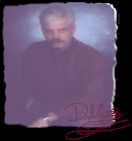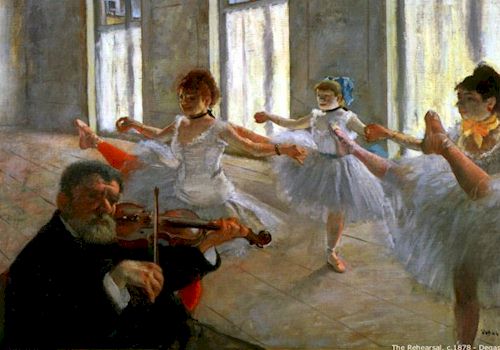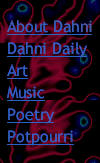![]()
![]()

Good day or good evening to you. You are here because a click of your mouse opened this page, you were curious to see what was here or I would like to think that you wanted to know something about me. What better place than from the horse's mouth, so to speak.
These are my words, this is my site, these are my works contained herein and no matter who might work on this site, any mistakes, errors and disdain you might develop for me or my works, I alone am responsible for the content. If you do not like what you see and experience here, then it is my fault and I am to blame. If you come to like or appreciate my work, then I have accomplished what is my true intention. If you have praise I'll share it with others that have contributed. If you have criticism of any kind, the bucks stop here, with me.
To begin, the first place to start is with my name. My name is Dahni, just Dahni and it is pronounced: (dah + knee). My name on my birth certificate is Donald, but my family and friends all either called me Donnie or still do. I chose the spelling of Dahni for myself. Its origin is Gaelic and the meaning is "world ruler", but I have no such worldly kingdom and barely have rule over myself. This is of course, a bit of humor, but something everyone should always aspire to, rule over oneself rather than, over others or being ruled over by others.
Perhaps the best way to define someone is not based on what they do, name recognition, fortune or fame, but by what they stand for and what they stand against.
My passion is art, music, photography, poetry, and writing. The word passion (singular), places these separate parts into a whole. While scholars and critics for centuries have argued and debated (and still do), over the meaning of poetry, I hold to a very simple definition. This same definition rings true for all the 'ARTS' and comes to us from ancient Greece. The Greek word for poem from which is derived such words as poet, and poetry is:
![]()
Poíéma (poy + a + ma), just simply means, "to do or to make." When it comes to language, a poem (something done or made), implies:
![]()
Speech has neither beauty nor its opposite, but this strange combination of words is called, a figure of speech. A figure of speech is a legitimate grammatical usage of words. Figures augment, emphasize, arrest our attention and may be 'truer to truth than a literal statement of fact.' As an example, the ground may be dry, but when a figure is added, the ground becomes 'thirsty'. This statement immediately is transformed into something more interesting and paints a vivid image in our minds. This 'picture' incidentally, makes it easier to recall.
As a side note, figures of speech were well known to the ancient Greeks and it is estimated that there were over 225 different kinds with sometimes, fifty variations under one figure. The King James version of the Bible utilizes 212 of these figures. Today, at the PhD level in universities, at best only 40-50 figures of speech are ever taught. One could spend a lifetime in this field alone! To my knowledge, only one man in the nineteenth century ever cataloged these 212 figures from the Bible, but he never had the time to work the entire 225, all the way through. His name is E.W. Bullinger. If you ever have the opportunity to pick up a copy of his work, 'Figures of Speech Used in the Bible,' it is an incredible research source for the study of Christianity and also, an invaluable tool for language and communication.
Why 212 figures used in the Bible? I don't know, but I do know that understanding figures of speech resolves apparent contradictions. Most writers and teachers are familiar with the word Anthropopathism especially, as it is used in children's literature - attributing human characteristics to animals etc. such as, talking fish or frogs driving cars. The word is again, from ancient Greece - anthropopathia (Gk.) - ("ways of the sons of men." The Hebrew is derek benai adam. The Latin word is condescenscio, from which the word condescension is derived. As a figure, it immediately arrests our attention when inanimate objects or other creatures are given human qualities. Condescension was not originally a derogatory word, but used to bring something from a higher level down to the level of ones present understanding, for the single purpose to elevate the thinking. The figure of speech condescenscio, is used quite often in the Bible. In one place the Bible says that "God is spirit," and in another is says "spirit hath no (does not have), form or comeliness (undetected by the five senses)." In many other places, we read such things as "God said," or "God bore his mighty arm." Without understanding figures of speech, people not only interpret what is meant to be figurative as literal, but interpret the literal as being figurative. In so doing, what one ends up with is a lot of apparent contradictions. Figures of speech cannot be interpreted or guessed at. They are scientifically precise and mathematically accurate. Their correct use in literature are as the techniques of a master painter.
Believe me, I am still on topic here and this brings us to language in general. In school, I despised the study of history. I was terrible at spelling, vocabulary and retention. One day, I began to notice how many of our English words actually came from ancient Greece. Greek culture was very ordered, logical, mathematical, precise and scientific. Even our word 'logic' comes from the Greek. Greek prepositions were illustrated by geometric shapes and line measurements.
In learning about these prepositions, some Greek, figures of speech and from reading an unabridged dictionary of the English language, my spelling greatly improved as did my vocabulary and memory. I grew passionate over language and my love for history and for WORDS just exploded! I also discovered that the more more you learn about a subject, the easier it is to recall.
To this day, I still defer and refer to an unabridged dictionary. In fact, I actually just enjoy reading it like perhaps you do with some great novel. An unabridged dictionary traces the origins of words. It may surprise you how many and how often even common words we hear and use everyday, have changed over the centuries. Still, I endeavor to use these words in writing for meaning and definition, as they were first used, despite how they may be presently used or have been corrupted in modern speech or writing.
Circling back over the 'Arts' again, we once more come to, "beauty of speech." Art to me, contains two equal sides: the technical and the spiritual or emotional sides. Without them both being equal in a work (Poíéma), of art, music, photography, poetry and writing, I do not know what they may be called, but I do not refer to them as being art, arts, or artistic. We know of great masters in art that produced masterpieces. A masterpiece takes considerable skill and time, often an entire lifetime to complete. Names such as Leonardo Da Vinci or Michelangelo among others, may instantly come to mind.
The 'ARTS' as almost any other profession (and yes, it is a profession), is not to be done for self alone. The 'ARTS' are to serve others just as a doctor is to serve a patient and a teacher is to serve the student. The skill of a surgeon in removing a ruptured appendix is important to life, but their 'bedside manner' has also, been proven to aide or hinder the healing process. A teacher may have command of their subject, but still fail to inspire the student. An artist may have incredible skill with their use of color, perspective, contrasts and many other techniques, but leave the viewer in a far worse state than perhaps they were before they viewed the work. Often this can occur at the subconscious level while the conscious mind is totally unaware of this immediately. I'll give one example.

'The Rehearsal'
Edgar Degas, French 1834-1917
Degas frequently both visited and painted works from the ballet. 'The Rehearsal' is one of these. In technique, it is a masterpiece, but what of the spiritual or emotional side? The lighting and color, perspective and contrasts; and the subjects draw our eyes to and into the piece. At first look, the theme is of dance and music, beauty, grace, motion and even the necessary discipline to attain the degree of flexibility shown. Even the way the violinist holds both his instrument and the bow show formal training.
As figures of speech and in this case images, what is to be expected, but is missing, draws our attention to it. What is missing from the musician? Despite this piece being entirely backlit, even a camera would have picked up a pin hole of light from his eyes and there is no doubt that Degas understood this. This is a fundamental technique in capturing realistic eyes in art. Why did he not do this and more importantly, what is the meaning or the feeling here by its absence? The colors and shape of the violinist's hand holding the bow, how does this make you feel? In looking deeper into this backlit piece, we notice that no light is apparent overhead or from the position of an audience. The faces of the dancers (especially the one in the middle), is there anything different about them? How do these faces make you feel? Is there any expression of joy here or do you feel any subject to display love or passion for their work? Perhaps you could interpret this piece as thus: it takes a lot of work, long hours and dedication to do what the subjects here do well, and are here therefore, shown to be exhausted? Does this picture display what we would expect from a performance in front of an audience, even if the audience consisted of only a director or choreographer? Would we instead expect what we first saw - dance and music, beauty, grace, motion, even the necessary discipline, rehearsing to perfect, for the performance? Would we then have seen life, joy, and passion from the faces of the dancers and the musician?
Interpretations as to the meaning of this piece could be nearly endless, but one thing is clear. There is absolutely nothing here that is indicative of enthusiasm. Are they all tired or in pain? Does anyone want to be here? Are they compelled to be here? Can they easily leave the frame or can the viewer? Only the individual can answer these and many others questions for themselves, as Degas is not here to tell us his meaning, but you cannot find a single smile here, captured at the moment, not in the faces of the dancers or the violinist.
click above to continue
![]()
Please choose your environment



for questions and concerns about this site:
Copyright © 2003 - 2006 I-IMAGINE. All rights reserved.
Privacy Policy
Copyright Issues
Contact us